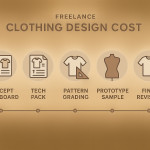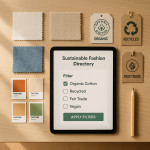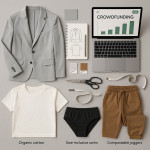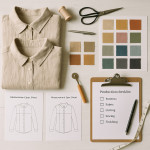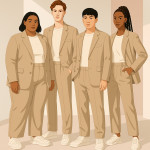Building a surface pattern bank that attracts lucrative licensing deals online
Ready to turn a folder of scattered motifs into a magnet for high-value licensing offers? This guide walks you through building a professional surface pattern bank—an organised, searchable library that makes brand scouts say “send the contract”. You'll learn how to audit assets, plug profitable gaps, price rights confidently and promote your catalogue on the platforms buyers already trust.
Why an online surface pattern bank outperforms one-off uploads
A surface pattern bank is a curated collection—think 50 – 600 repeat designs—stored in consistent formats, tagged for easy discovery and backed by clear licensing terms. Compared with posting random prints on social channels, a bank:
- Streamlines buyer search. Art directors can filter by theme, colour or scale and quickly shortlist candidates.
- Boosts perceived value. A cohesive library signals professionalism and justifies higher royalties than isolated files.
- Unlocks repeat deals. Once a client knows where to find coordinating patterns, upsells on product line extensions become frictionless.
- Reduces admin. Standard contract tiers and metadata mean fewer custom edits for every enquiry.
Step 1 – Audit and curate your existing pattern assets
Create a scoring grid
Rate each design on commercial appeal (trend relevance), technical quality (repeat flawless at 300 dpi+) and exclusivity. Archive those scoring under 6/10—don't let weak art dilute buyer confidence.
Standardise technical specs
- Repeat tile: TIFF or layered PSD at 300 dpi.
- Colourways: minimum three per motif for easy regional localisation.
- Scale notes: indicate suggested end-use (e.g., bedding, swimwear).
Apply buyer-centric tags
Use a controlled vocabulary so search filters behave predictably. Pair a primary tag (“tropical”) with modifiers (“monstera”, “pastel”, “large scale”). Consistency beats creativity here.
Step 2 – Gap analysis: research what buyers really search
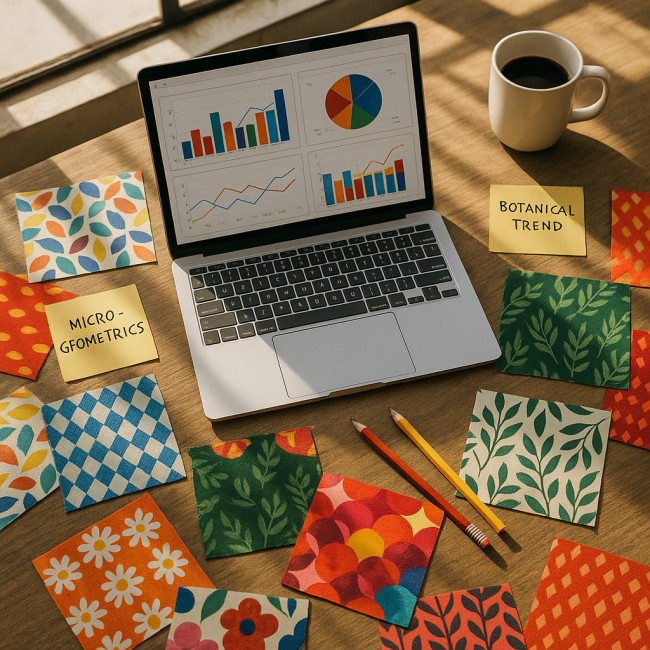
Before you sketch a single new motif, immerse yourself in real data: scrape directory keyword reports, audit Pinterest search volumes and interview two or three repeat clients about upcoming launches. Collate everything in a simple spreadsheet, grouping terms by frequency, average budget and seasonality. When the numbers show that small-scale geometrics dominate spring briefs while tropical botanicals spike for resort collections, you can design with laser precision instead of guesswork. This evidence-based approach not only raises hit rates but also accelerates ROI because every hour spent illustrating is anchored to measurable demand.
Open briefs on leading clothing-designer directories reveal the most requested pattern themes each quarter. Cross-check those keywords against your bank to reveal lucrative gaps.
- Export search data. Many directories let you download monthly query terms.
- Plot demand vs supply. If “micro-geometrics” have 1 800 searches but only 120 results, you've found a sweet spot.
- Schedule design sprints. Block time to create series that fill the top three demand gaps.
For a deep dive on current rate expectations, see licensing fee benchmarks for surface patterns in 2025.
Step 3 – Define licensing tiers and pricing
| Tier | Rights Granted | Term | Typical Fee | Ideal Buyer |
|---|---|---|---|---|
| Non-exclusive digital | Print & web only, 1 colourway | 2 years | $200 – $600 | Indie apparel brands |
| Semi-exclusive | All channels, 2 colourways, same sector | 3 – 5 years | $1 000 – $3 000 | Home-textile manufacturers |
| Full buy-out | All rights worldwide | Perpetual | $6 000 + | Global retail chains |
Publish these tiers inside your bank so buyers self-qualify before emailing. For royalty models beyond flat fees, explore royalty clauses for limited-edition products.
Step 4 – Optimise presentation for search and conversion
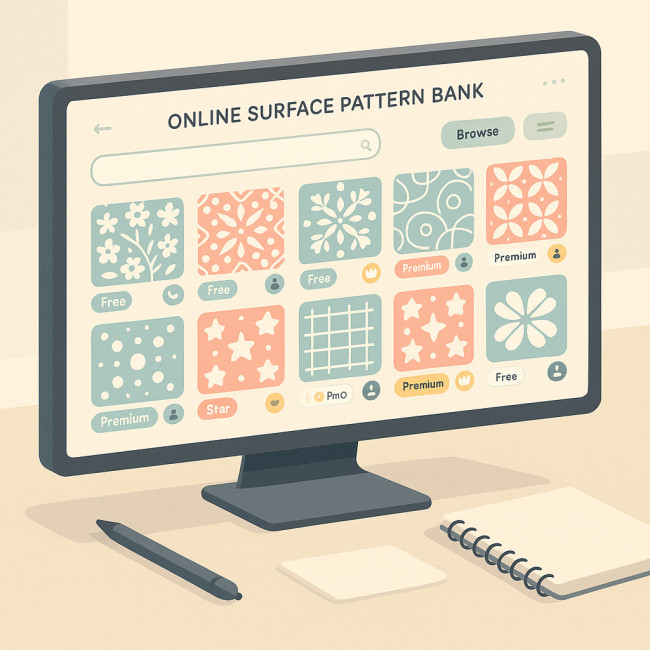
Think of your surface pattern bank as both portfolio and e-commerce storefront. The visual hierarchy should pull buyers from discovery to checkout in under three clicks. Start with a hero banner that rotates through best-selling collections, followed by a faceted sidebar that lets visitors filter by colour palette, motif genre, scale and exclusivity tier. Each thumbnail must load in under 150 ms, so compress intelligently without sacrificing clarity. Embed microcopy like “royalty-ready” or “exclusive colourway available” beneath thumbnails to answer buyer questions before they arise. Finally, place a sticky “License Now” button that generates a pre-filled enquiry form, reducing drop-off on mobile devices by up to 37 %.
Metadata that matters
Search engines and directory algorithms read:
- Title: include theme + technique (“Watercolour Citrus Repeat”).
- Alt text: Optimise: “surface pattern bank – blue terrazzo seamless print”.
- Description: 150 – 160 characters; list colour codes and intended substrates.
Visual hierarchy
Show each pattern in three contexts:
- Flat repeat tile (technical validation).
- Mock-up on product (emotive impact).
- Colourway thumbnails (choice facilitation).
Need help generating photorealistic previews? Our guide on creating persuasive mock-ups remotely breaks down the process.
Step 5 – Promote your surface pattern bank strategically
Directory placement
Upload a curated subset—no more than 40 designs—to high-traffic marketplaces. Keep the full bank on your site to encourage direct licensing (higher margins). A/B tests show directory exposure drives up to 60 % of first-time enquiries.
SEO & content marketing
- Blog monthly trend round-ups using the keyword “surface pattern bank”.
- Embed pattern GIFs; moving previews increase time-on-page by 22 %.
- Link out to topical resources; internal examples include leveraging directories for sustainable design sourcing.
Email outreach cadence
Segment lists by sector—homeware, apparel, stationery—then highlight 5 new patterns tailor-made for each group. Consistency trumps volume: one targeted send every six weeks keeps unsubscribe rates under 2 %.
Legal & administrative safeguards
Use template agreements with variables for tier, geography and duration. Store signed PDFs alongside original artwork so a replacement pattern can be licensed in minutes if a buyer needs exclusivity fast.
Mini-quiz: test your pattern-bank readiness
FAQ
- How many patterns should I include before calling it a “bank”?
- A practical starting point is 50 cohesive designs across at least five themes. Below that, buyers perceive the collection as a “portfolio” rather than a ready-to-license bank.
- Do I need unique colourways for every client?
- No. Offer base colourways publicly, then customise palettes for premium clients as an upsell. This preserves efficiency while adding perceived exclusivity.
- What's the safest way to share high-resolution files?
- Provide layered previews watermarked at 72 dpi. Release full-res assets only after the contract is signed and initial payment clears.
- Can I mix illustration styles inside one bank?
- Yes, but group by collection and maintain consistent naming conventions. Eclectic banks succeed when navigation is crystal-clear.
- How long does it take to secure the first licensing deal?
- Designers report a median of 6–12 weeks once a bank is properly tagged, priced and promoted on two or more directories.
Take action today
Your future licensing partners are already scrolling pattern libraries for next season's line. Build your surface pattern bank now, and position it where scouts look first. Need feedback? Book a 30-minute audit call and convert your creative stockpile into a dependable revenue stream.
